Dell Precision M6700 Notebook Review: The Enterprise Split
by Dustin Sklavos on December 12, 2012 7:43 PM ESTApplication and Futuremark Performance
The Intel Core i7-3920XM CPU that powers our Dell Precision M6700 review unit isn't just the fastest notebook CPU we've tested, it's also potentially as fast as a desktop Ivy Bridge processor. At the same time, the NVIDIA Quadro K5000M is based on the fastest mobile gaming GPU currently available, and the M6700 is also enjoying a Samsung PM830 SSD as its system drive. All told, this should be the fastest notebook we've tested thus far.
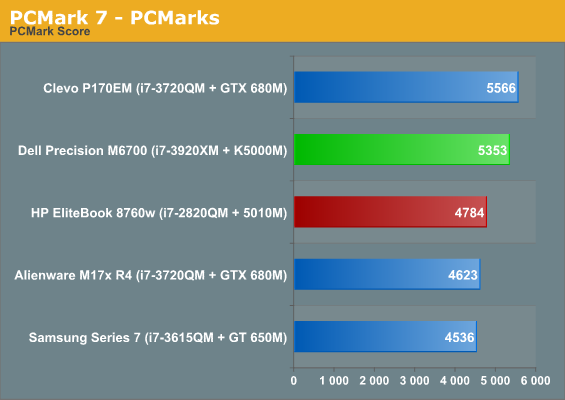

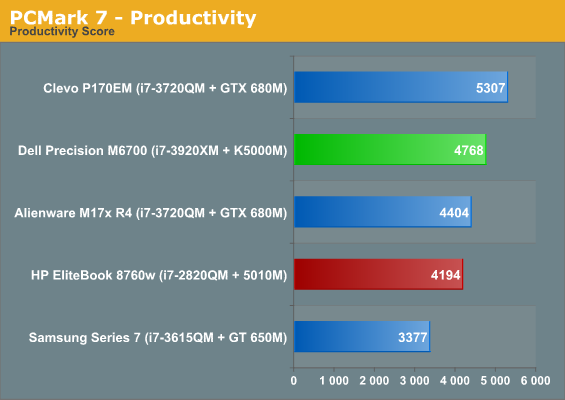
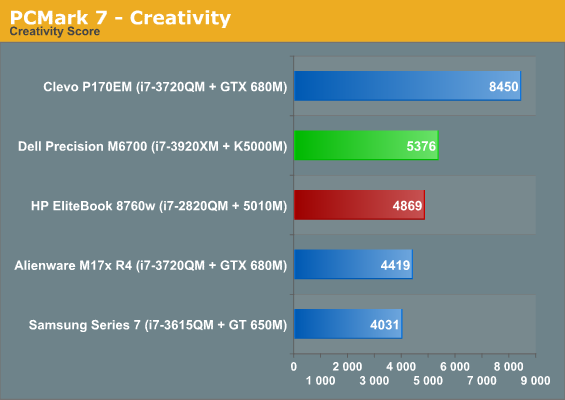
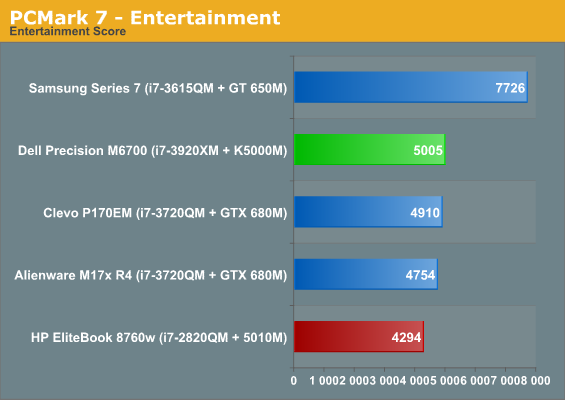
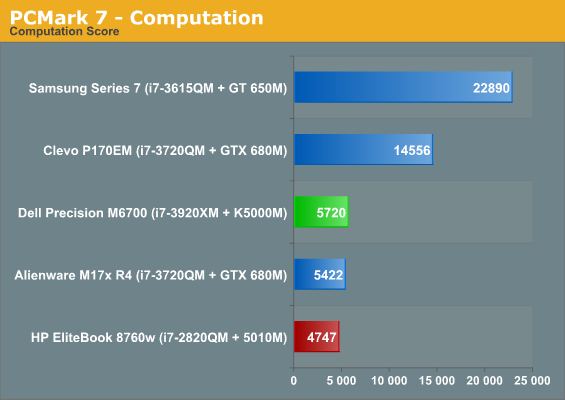
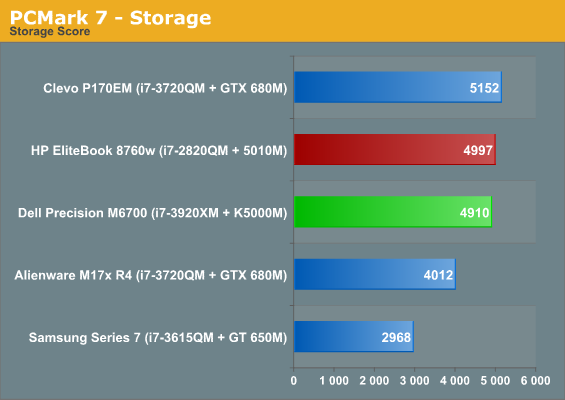
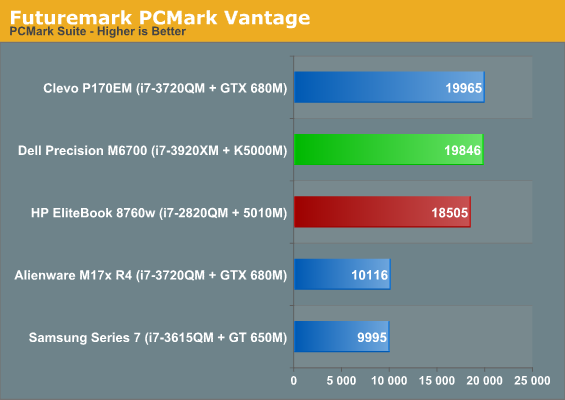
So what happened? It looks like PCMark slightly favors the Crucial m4 SSD the Clevo notebook uses. That's unfortunate, and frustrating, as once again PCMark shows it skews so hard towards the SSD that a system with a substantially more powerful CPU (lack of access to QuickSync notwithstanding), the Dell Precision M6700, is somehow eclipsed by a gaming notebook. But then I've been campaigning to remove PCMark from our testbed for some time now.
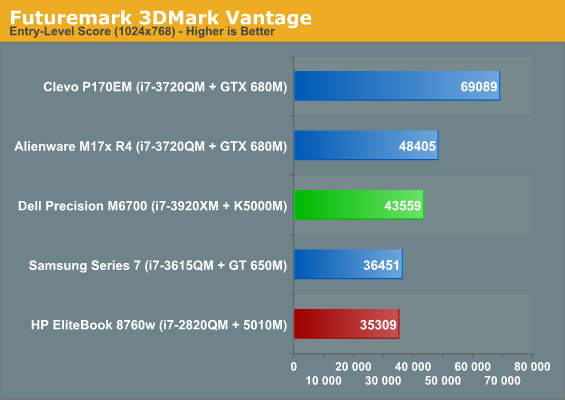
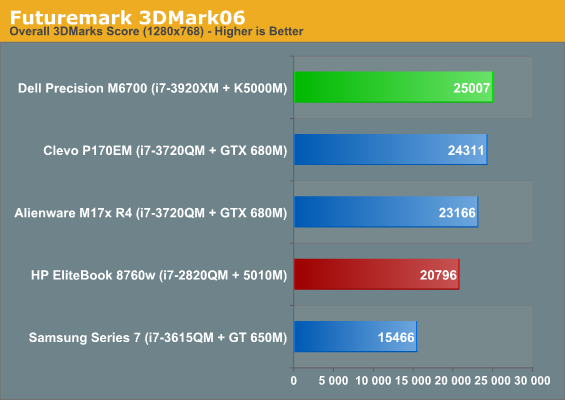
3DMark06 at least reveals the substantial performance of the i7-3920XM.
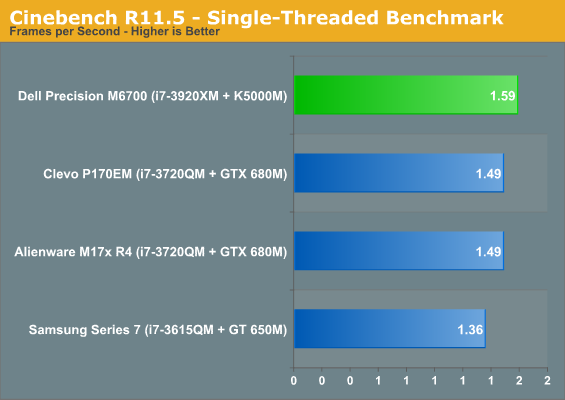
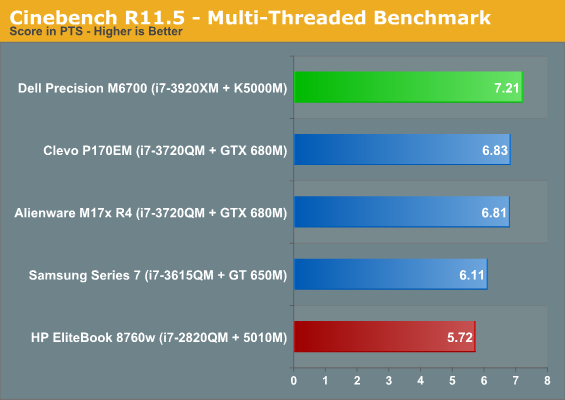
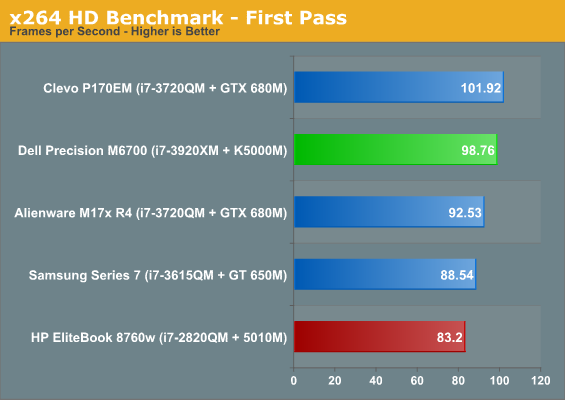

Inexplicably, Clevo's P170EM is able to produce better first pass results in our x264 benchmark, but in all other cases the M6700 is faster. For comparison sake, a stock i7-3770K (the one in the HP h9 Phoenix) is able to produce 100fps in the first x264 pass and 40.51fps in the second; that means that Intel's fastest (well, second-fastest now that the i7-3940XM is available) mobile chip is actually able to nip the heels of their fastest mainstream desktop chip. That also means that the 100MHz bump to the 3940XM is probably enough to get it to 3770K-level performance, which is frankly astonishing.










125 Comments
View All Comments
ijozic - Friday, December 14, 2012 - link
I'm not sure, do a search on the net? I think it's probably an 8-bit IPS since it has switchable graphics..kabelmk - Friday, December 14, 2012 - link
I've tried to do a quick search and i couldn't find something concrete. I didn't know about Intel integrated graphics limitation (that can drive up to 8-bit panels only).Based on anandtech color gamut chart, it seems like the Retina MBP panel can't be better than 8-bit.
Hm, interesting ...
j_newbie - Thursday, December 13, 2012 - link
I bought a m4600 refurb last year.I mainly use ansys and other cae software on it.
I can honestly say that it has been an amazing laptop, mainly thanks to the cooling system. I can run 24 hours at 100% cpu load with the hdd not even 50 deg C.
Its a little bulky granted.
The user access panel allows you to pull the fans out for cleaning which not many other notebooks do.
They need to redesign the 180W power brick though, its too big.
The touchpad buttons are great and the layout is fine with me.
Its worth it if you can buy@dell outlet. some great deals out there.
I picked up mine for 1000$ came with i7-2720qm, fast 7200 rpm disk, 4 gb ram, long life 87wh battery, 1080p screen, firepro m5950.
Currently its got 32gb ram, a second hdd using an aftermarket caddy.
I can play Dota 2 on it with the thermals barely above 60 deg C (Its the only game I play)
Its taken a few drops and falls, some tough field conditions and lots of other abuse and it just keeps going.
I usually change my laptop every year (buying midrange stuff) but this one I am keeping for another year atleast.
Great job dell, who cares about the aesthetics, Reminds me a bit of the original thinkpads, tough as nails and looks like your grandpa's laptop.
Cheers,
J
AnnoyedGrunt - Thursday, December 13, 2012 - link
I have the smaller, previous generation 4600 for my work machine and find it to be a great laptop.I'm a mechanical engineer, and use it for Solidworks, Pro/E, their respective FEA programs, CFD, and Matlab, and have been very happy with the laptop so far.
The only flimsy thing I notice is that when closed, the screen does not clamp firmly to the base. The latches leave quite a bit of play, but at least they are metal and look to be robust.
I typically have the laptop docked at work, but can easily take it home when necessary. I can run Solidworks for a few hours on battery power, and with the three button trackpad can scrape by without a separate mouse if necessary (although it is painful). I don't notice the keyboard layout issues much, but that's because I'm not big on the document navigation because I almost alway have a mouse in hand for CAD work.
Overall I'm quite happy with the machine, but haven't had any others to compare it to.
-AG
piroroadkill - Thursday, December 13, 2012 - link
"I may be too critical of Dell's Precision M6700. It has the performance, it has the price, it has the expandability, and looks aren't everything."I think you are, definitely. Most people at their desk are going to use it in a docking station with external KB/monitor/mouse.
The sheer amount of expansion available in this and the power makes it unrivalled. Who cares about the rest of the stuff you mentioned?
piroroadkill - Thursday, December 13, 2012 - link
Just to expand on this - people who actually need to get shit done are going to pick this up.If you're not that guy, you shouldn't be bothering with reading about a workstation, surely..
Siorus - Thursday, December 13, 2012 - link
I'm really surprised by the tone of the article and a lot of the comments here. I strongly disagree with your assessment of the M6700's chassis, Dustin; the things that you find nonsensical appear to be quite straightforward to me.I can't speak to the relative feel of the HP chassis vs. the Dell, because I haven't used the HP. I do, however, have a M6600-which uses an identical chassis to the M6700-and having read your own review of the HP I would argue your contention that the HP is more functional.
I use the calculator shortcut on my machine multiple times a day, and I prefer the page up/page down keys next to the arrow keys as opposed to up at the top of the machine. Why? Because it requires that I move my hand a shorter distance to access them, and I use them quite literally hundreds of times a day; it's an easier, faster method of scrolling than using the touchpad, particularly if you read as quickly as I do. The media keys make no difference to me one way or the other; I never use them, but I don't see what they'd be replaced with that would improve the functionality of the keyboard.
I do not find the touchpad too small; I don't need or want a large touchpad. Why on earth would you want to map cursor movement across a larger space when you can accomplish the same thing in 1" (which is about how much of the touchpad on the Dell I make use of)? You wind up moving your finger further-and thus taking more time-for no reason. Is the average person's hand-eye coordination and spatial awareness really so poor that they need to map cursor position on a 17" screen across a 4" touchpad for accurate mousing? It just strikes me as a wholly unnecessary waste of space.
Regarding ease of service, I think you have latched onto the least relevant aspect of the whole process. Go back and look at your review of the HP, specifically the picture with the bottom cover removed. Quite a bit of the machine is still obscured by the case. On the Dell, the entire underside of the machine is exposed, including both of the fans, which are easy to remove either for replacement or to properly clean the heatsinks. The HP's fan is only accessible if you disassemble the entire machine, and if you look at the relative thermal performance of the two machines you will find that the HP's thermal solution is an exceptionally-indeed, inexcusably, in this class of machine-poor piece of engineering.
The HP's CPU temperatures are comparable to the Dell's, but the HP's 2820qm is a 35w part versus the 55w 3920xm in the Dell, and the Dell's GPU runs considerably cooler than the HP's, despite having an identical TDP (for the record, I have several M6600s with Quadro 5010ms and i7 2960xms deployed that also run considerably cooler than the HP you tested does.).
I think the quick release hard drive that's screwed into the chassis that you complained about makes quite a bit of sense if you view it as a security feature. The drive does not need to be screwed into the chassis to stay in place, the quick release mechanism alone will hold it securely. You have the option of screwing the drive into the machine, which makes running off with the drive somewhat more inconvenient.
With respect to the "cobbled-together" impression you got from the M6700, my personal M6600 took an unprotected fall out of the back of a Yukon XL onto asphalt, landing on the right rear corner. The case had some minor damage but the machine was 100% functional. The only piece that I can find on these things that feels flimsy and "cobbled together" is the plastic bezel around the keyboard, which needs to be removed to access two of the four RAM slots. On the other hand, judging by the pictures of the HP, you'll be removing the keyboard to get access to two RAM slots on that, too, and since the whole top panel on that appears to be one piece, I'm going to guess that that's probably a much more involved process than it is on the Dell.
I'm afraid that I just can't see any relevant criterion by which the HP could be judged to be a better machine. It's both heavier and larger than the Dell (although the differences in both measurements are, admittedly, essentially academic in nature), the thermal performance is embarrassing, and-once the bottom cover is removed-it is not as easily serviced as the Dell. It seems to me that if you buy the HP, you're paying more for the privilege of owning a lower quality machine.
With respect to the commenters comparing this machine to anything Apple makes, all I can say is "get real." I own two Macbook Pros, a Macbook, two iPads and an iPhone; I'd hardly call myself biased against Apple products. But any attempt to present a Macbook Pro as a credible alternative to a mobile workstation such as the M6700 or the HP 8770w is indicative of a complete lack of even the most basic understanding of either product.
Apple does not build high end mobile computers for serious business applications; in fact, they don't really build high end computers for serious business applications, full stop. If all you want to do is watch movies, play some fairly lightweight video games, or do some very basic work in programs like Photoshop or Lightroom, the Macbook Pro will suit your needs just fine.
But the Macbook Pro will not handle serious CAD applications; there is no Solidworks or Pro-E on the Apple platform because their machines use consumer GPUs that do not have the driver support for proper OGL acceleration in CAD/CAM applications, and the machine does not support the installation of enough RAM to maintain acceptable performance if you're trying to use it for serious engineering work.
The M6700 and the 8770w are not designed for or marketed to people wanting to do copy editing for a newspaper. They are built for people that need mobile platforms on which they can do real work.
The TDP of the CPU and the GPU COMBINED in the current, TOTL 17" Retina MBP is less than the TDP of the graphics card alone in the M6700 in this article, and the Mac has problems handling *that* heat load. The kind of power that is required to render a solidworks assembly with hundreds or thousands of parts in real time doesn't fit in a 3/4" thick notebook. Cosmetics aren't real important in this category; the target market for these machines is the manufacturing industry, not graphic designers.
The Macbook Pro is not a high end mobile workstation; it never has been. And that's fine, it has its own niche and its own design criterion which it meets very well. But to compare it with the class of PC notebooks which the M6700 is a member of is, at best, the height of ignorance.
theeldest - Thursday, December 13, 2012 - link
Thank you.I came here to say much of the same but you did better than I ever could.
I absolutely agree on the calculator button. I have one keyboard that doesn't have it near the numberpad and it drives me crazy.
And finally, am I the only one that likes the aesthetics of the Dell more than the HP? Seriously, it looks better.
BitJunkie - Thursday, December 13, 2012 - link
No! you aren't. For different reasons, the company I work for has 50% Dell and 50% HP computers. I have a M6600 and wouldn't trade it for one of my colleagues HPs.I say that from the perspective of aesthetics, as well as performance. I don't care about how the thing looks, it's just a very fast and solid bit of kit for running 2D / 3D FEA.
I'm not a mechanical engineer: more interested in soil mechanics and using advanced constitutive models that couple strength with stress-state and volume change: so volumetric / shear hardening and softening. I look at this for offshore structures for oil and gas projects.
These powerful laptops have really changed our workflow and how we resolve some really difficult challenges.
I find the pg up and pg dwn keys to be quite convenient too.
I like the work that anandtech do, but this review is basically a consumer review of a professional bit of kit. The really important stuff about how fast a 3D mesh will generate, decompose and then be solved using different types of iterative solver is missing....
Shame, but hey ho.
RedWingB - Thursday, December 13, 2012 - link
I agree.I feel that this review is poor and time and time again attributes huge importance to minor differences when comparing the new Precision to HP's counterpart. For the record, I own both an 8760w and an M6600 and whilst they're both great notebooks, the significantly better thermal solution of the Precision line is what I find most useful as a power user. Pushing your system to the limits by overclocking your GPU and CPU in the Elitebook? Forget about it. The system will handle it fine but your temps will be hitting 95 Celsius + in no time, your system will sound like a jet engine, compared to the Precision whose better thermal solution allows harder overclocks, lower temperatures and lower fan noise, consistently.
Some may also argue that the look and feel of the Precision are more business appropriate.
As for the display comparisons between the M6700 and 8760W (PremierColor vs Dreamcolor), well I'm not too sure about this, I know for a fact that they both use identical LG panels so I guess the difference may be attributed to what happens on the software side.